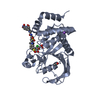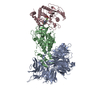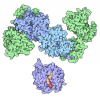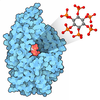+ Open data
Open data
- Basic information
Basic information
| Entry | Database: PDB / ID: 8uh6 | ||||||
|---|---|---|---|---|---|---|---|
| Title | Degrader-induced complex between PTPN2 and CRBN-DDB1 | ||||||
 Components Components |
| ||||||
 Keywords Keywords | HYDROLASE | ||||||
| Function / homology |  Function and homology information Function and homology informationnegative regulation of interleukin-2-mediated signaling pathway / negative regulation of positive thymic T cell selection / positive regulation of PERK-mediated unfolded protein response / negative regulation of interleukin-4-mediated signaling pathway / negative regulation of platelet-derived growth factor receptor-beta signaling pathway / negative regulation of macrophage colony-stimulating factor signaling pathway / negative regulation of interleukin-6-mediated signaling pathway / regulation of type II interferon-mediated signaling pathway / negative regulation of macrophage differentiation / negative regulation of tyrosine phosphorylation of STAT protein ...negative regulation of interleukin-2-mediated signaling pathway / negative regulation of positive thymic T cell selection / positive regulation of PERK-mediated unfolded protein response / negative regulation of interleukin-4-mediated signaling pathway / negative regulation of platelet-derived growth factor receptor-beta signaling pathway / negative regulation of macrophage colony-stimulating factor signaling pathway / negative regulation of interleukin-6-mediated signaling pathway / regulation of type II interferon-mediated signaling pathway / negative regulation of macrophage differentiation / negative regulation of tyrosine phosphorylation of STAT protein / negative regulation of chemotaxis / positive regulation of endoplasmic reticulum stress-induced intrinsic apoptotic signaling pathway / negative regulation of monoatomic ion transmembrane transport / negative regulation of receptor signaling pathway via JAK-STAT / positive regulation by virus of viral protein levels in host cell / Interleukin-37 signaling / spindle assembly involved in female meiosis / epigenetic programming in the zygotic pronuclei / UV-damage excision repair / syntaxin binding / negative regulation of type I interferon-mediated signaling pathway / biological process involved in interaction with symbiont / regulation of mitotic cell cycle phase transition / regulation of hepatocyte growth factor receptor signaling pathway / WD40-repeat domain binding / insulin receptor recycling / negative regulation of T cell receptor signaling pathway / Cul4A-RING E3 ubiquitin ligase complex / Cul4-RING E3 ubiquitin ligase complex / STAT family protein binding / Cul4B-RING E3 ubiquitin ligase complex / ubiquitin ligase complex scaffold activity / negative regulation of type II interferon-mediated signaling pathway / endoplasmic reticulum-Golgi intermediate compartment / negative regulation of epidermal growth factor receptor signaling pathway / negative regulation of reproductive process / negative regulation of developmental process / locomotory exploration behavior / peptidyl-tyrosine dephosphorylation / non-membrane spanning protein tyrosine phosphatase activity / cullin family protein binding / viral release from host cell / T cell differentiation / negative regulation of lipid storage / positive regulation of Wnt signaling pathway / negative regulation of tumor necrosis factor-mediated signaling pathway / ectopic germ cell programmed cell death / Regulation of IFNG signaling / negative regulation of protein-containing complex assembly / positive regulation of viral genome replication / proteasomal protein catabolic process / protein-tyrosine-phosphatase / positive regulation of gluconeogenesis / negative regulation of insulin receptor signaling pathway / protein tyrosine phosphatase activity / B cell differentiation / endosome lumen / erythrocyte differentiation / nucleotide-excision repair / positive regulation of protein-containing complex assembly / Recognition of DNA damage by PCNA-containing replication complex / Negative regulation of MET activity / regulation of circadian rhythm / DNA Damage Recognition in GG-NER / receptor tyrosine kinase binding / PKR-mediated signaling / negative regulation of ERK1 and ERK2 cascade / Dual Incision in GG-NER / Transcription-Coupled Nucleotide Excision Repair (TC-NER) / Formation of TC-NER Pre-Incision Complex / negative regulation of inflammatory response / Formation of Incision Complex in GG-NER / integrin binding / Wnt signaling pathway / Dual incision in TC-NER / Gap-filling DNA repair synthesis and ligation in TC-NER / positive regulation of protein catabolic process / cellular response to UV / rhythmic process / insulin receptor signaling pathway / glucose homeostasis / site of double-strand break / Neddylation / ubiquitin-dependent protein catabolic process / protein-macromolecule adaptor activity / Potential therapeutics for SARS / proteasome-mediated ubiquitin-dependent protein catabolic process / damaged DNA binding / transmembrane transporter binding / chromosome, telomeric region / protein ubiquitination / negative regulation of cell population proliferation / DNA repair / apoptotic process / DNA damage response / protein kinase binding / negative regulation of apoptotic process / protein-containing complex binding / nucleolus / perinuclear region of cytoplasm Similarity search - Function | ||||||
| Biological species |  Homo sapiens (human) Homo sapiens (human) | ||||||
| Method | ELECTRON MICROSCOPY / single particle reconstruction / cryo EM / Resolution: 3.3 Å | ||||||
 Authors Authors | Catalano, C. / Bratkowski, M. / Scapin, G. / Hao, Q. | ||||||
| Funding support | 1items
| ||||||
 Citation Citation |  Journal: Commun Chem / Year: 2024 Journal: Commun Chem / Year: 2024Title: Mechanistic insights into a heterobifunctional degrader-induced PTPN2/N1 complex. Authors: Qi Hao / Manoj K Rathinaswamy / Kelly L Klinge / Matthew Bratkowski / Amirhossein Mafi / Christina K Baumgartner / Keith M Hamel / Gesine K Veits / Rinku Jain / Claudio Catalano / Mark ...Authors: Qi Hao / Manoj K Rathinaswamy / Kelly L Klinge / Matthew Bratkowski / Amirhossein Mafi / Christina K Baumgartner / Keith M Hamel / Gesine K Veits / Rinku Jain / Claudio Catalano / Mark Fitzgerald / Alexander W Hird / Eunice Park / Harit U Vora / James A Henderson / Kenton Longenecker / Charles W Hutchins / Wei Qiu / Giovanna Scapin / Qi Sun / Vincent S Stoll / Chaohong Sun / Ping Li / Dan Eaton / David Stokoe / Stewart L Fisher / Christopher G Nasveschuk / Marcia Paddock / Michael E Kort /  Abstract: PTPN2 (protein tyrosine phosphatase non-receptor type 2, or TC-PTP) and PTPN1 are attractive immuno-oncology targets, with the deletion of Ptpn1 and Ptpn2 improving response to immunotherapy in ...PTPN2 (protein tyrosine phosphatase non-receptor type 2, or TC-PTP) and PTPN1 are attractive immuno-oncology targets, with the deletion of Ptpn1 and Ptpn2 improving response to immunotherapy in disease models. Targeted protein degradation has emerged as a promising approach to drug challenging targets including phosphatases. We developed potent PTPN2/N1 dual heterobifunctional degraders (Cmpd-1 and Cmpd-2) which facilitate efficient complex assembly with E3 ubiquitin ligase CRL4, and mediate potent PTPN2/N1 degradation in cells and mice. To provide mechanistic insights into the cooperative complex formation introduced by degraders, we employed a combination of structural approaches. Our crystal structure reveals how PTPN2 is recognized by the tri-substituted thiophene moiety of the degrader. We further determined a high-resolution structure of DDB1-CRBN/Cmpd-1/PTPN2 using single-particle cryo-electron microscopy (cryo-EM). This structure reveals that the degrader induces proximity between CRBN and PTPN2, albeit the large conformational heterogeneity of this ternary complex. The molecular dynamic (MD)-simulations constructed based on the cryo-EM structure exhibited a large rigid body movement of PTPN2 and illustrated the dynamic interactions between PTPN2 and CRBN. Together, our study demonstrates the development of PTPN2/N1 heterobifunctional degraders with potential applications in cancer immunotherapy. Furthermore, the developed structural workflow could help to understand the dynamic nature of degrader-induced cooperative ternary complexes. | ||||||
| History |
|
- Structure visualization
Structure visualization
| Structure viewer | Molecule:  Molmil Molmil Jmol/JSmol Jmol/JSmol |
|---|
- Downloads & links
Downloads & links
- Download
Download
| PDBx/mmCIF format |  8uh6.cif.gz 8uh6.cif.gz | 320.3 KB | Display |  PDBx/mmCIF format PDBx/mmCIF format |
|---|---|---|---|---|
| PDB format |  pdb8uh6.ent.gz pdb8uh6.ent.gz | 244.6 KB | Display |  PDB format PDB format |
| PDBx/mmJSON format |  8uh6.json.gz 8uh6.json.gz | Tree view |  PDBx/mmJSON format PDBx/mmJSON format | |
| Others |  Other downloads Other downloads |
-Validation report
| Summary document |  8uh6_validation.pdf.gz 8uh6_validation.pdf.gz | 1.6 MB | Display |  wwPDB validaton report wwPDB validaton report |
|---|---|---|---|---|
| Full document |  8uh6_full_validation.pdf.gz 8uh6_full_validation.pdf.gz | 1.7 MB | Display | |
| Data in XML |  8uh6_validation.xml.gz 8uh6_validation.xml.gz | 56.1 KB | Display | |
| Data in CIF |  8uh6_validation.cif.gz 8uh6_validation.cif.gz | 80.5 KB | Display | |
| Arichive directory |  https://data.pdbj.org/pub/pdb/validation_reports/uh/8uh6 https://data.pdbj.org/pub/pdb/validation_reports/uh/8uh6 ftp://data.pdbj.org/pub/pdb/validation_reports/uh/8uh6 ftp://data.pdbj.org/pub/pdb/validation_reports/uh/8uh6 | HTTPS FTP |
-Related structure data
| Related structure data |  42247MC  8u0hC M: map data used to model this data C: citing same article ( |
|---|---|
| Similar structure data | Similarity search - Function & homology  F&H Search F&H Search |
- Links
Links
- Assembly
Assembly
| Deposited unit | 
|
|---|---|
| 1 |
|
- Components
Components
| #1: Protein | Mass: 128333.820 Da / Num. of mol.: 1 Source method: isolated from a genetically manipulated source Source: (gene. exp.)  Homo sapiens (human) / Gene: DDB1 / Production host: Homo sapiens (human) / Gene: DDB1 / Production host:  |
|---|---|
| #2: Protein | Mass: 51777.020 Da / Num. of mol.: 1 Source method: isolated from a genetically manipulated source Source: (gene. exp.)  Homo sapiens (human) / Gene: CRBN / Production host: Homo sapiens (human) / Gene: CRBN / Production host:  |
| #3: Protein | Mass: 37966.000 Da / Num. of mol.: 1 / Fragment: UNP residues 1-314 Source method: isolated from a genetically manipulated source Source: (gene. exp.)  Homo sapiens (human) / Gene: PTPN2, PTPT / Production host: Homo sapiens (human) / Gene: PTPN2, PTPT / Production host:  |
| #4: Chemical | ChemComp-WO8 / ( Mass: 976.512 Da / Num. of mol.: 1 / Source method: obtained synthetically / Formula: C46H50ClN7O11S2 / Feature type: SUBJECT OF INVESTIGATION |
| #5: Chemical | ChemComp-ZN / |
| Has ligand of interest | Y |
-Experimental details
-Experiment
| Experiment | Method: ELECTRON MICROSCOPY |
|---|---|
| EM experiment | Aggregation state: PARTICLE / 3D reconstruction method: single particle reconstruction |
- Sample preparation
Sample preparation
| Component | Name: CRBN-DDB1-PTPN2 complex / Type: COMPLEX / Entity ID: #1-#3 / Source: RECOMBINANT |
|---|---|
| Molecular weight | Value: 0.21781996 MDa / Experimental value: NO |
| Source (natural) | Organism:  Homo sapiens (human) Homo sapiens (human) |
| Source (recombinant) | Organism:  |
| Buffer solution | pH: 7.4 |
| Specimen | Embedding applied: NO / Shadowing applied: NO / Staining applied: NO / Vitrification applied: YES |
| Vitrification | Cryogen name: ETHANE |
- Electron microscopy imaging
Electron microscopy imaging
| Experimental equipment |  Model: Titan Krios / Image courtesy: FEI Company |
|---|---|
| Microscopy | Model: FEI TITAN KRIOS |
| Electron gun | Electron source:  FIELD EMISSION GUN / Accelerating voltage: 300 kV / Illumination mode: FLOOD BEAM FIELD EMISSION GUN / Accelerating voltage: 300 kV / Illumination mode: FLOOD BEAM |
| Electron lens | Mode: BRIGHT FIELD / Nominal defocus max: 2000 nm / Nominal defocus min: 1000 nm |
| Image recording | Electron dose: 36.09 e/Å2 / Film or detector model: GATAN K3 BIOQUANTUM (6k x 4k) |
- Processing
Processing
| CTF correction | Type: PHASE FLIPPING AND AMPLITUDE CORRECTION |
|---|---|
| 3D reconstruction | Resolution: 3.3 Å / Resolution method: FSC 0.143 CUT-OFF / Num. of particles: 69542 / Symmetry type: POINT |
 Movie
Movie Controller
Controller



 PDBj
PDBj












